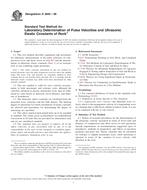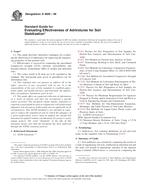Potřebujeme váš souhlas k využití jednotlivých dat, aby se vám mimo jiné mohly ukazovat informace týkající se vašich zájmů. Souhlas udělíte kliknutím na tlačítko „OK“.
ASTM D2845-08
Standard Test Method for Laboratory Determination of Pulse Velocities and Ultrasonic Elastic Constants of Rock (Withdrawn 2017)
Automaticky přeložený název:
Standardní zkušební metoda pro laboratorní stanovení Pulse rychlostí a ultrazvukových elastických konstant of Rock
NORMA vydána dne 1.7.2008
Informace o normě:
Označení normy: ASTM D2845-08
Poznámka: NEPLATNÁ
Datum vydání normy: 1.7.2008
Kód zboží: NS-21688
Počet stran: 7
Přibližná hmotnost: 21 g (0.05 liber)
Země: Americká technická norma
Kategorie: Technické normy ASTM
Kategorie - podobné normy:
Zemní práce. Hloubicí práce. Budování základů. Podzemní práce
Anotace textu normy ASTM D2845-08 :
Keywords:
compression testing, anisotropy, ultrasonic testing, velocity-pulse, Anisotropy, Elastic constants, Isotropic rock specimens, Pulse velocity, Rock materials/properties/analysis, Shear testing--rock, Ultrasonic testing--environmental materials/applications, ICS Number Code 93.020 (Earth works. Excavations. Foundation construction. Underground works)
Doplňující informace
| Significance and Use | ||||||||||
|
The primary advantages of ultrasonic testing are that it yields compression and shear wave velocities, and ultrasonic values for the elastic constants of intact homogeneous isotropic rock specimens (3). Elastic constants are not to be calculated for rocks having pronounced anisotropy by procedures described in this test method. The values of elastic constants often do not agree with those determined by static laboratory methods or the in situ methods. Measured wave velocities likewise may not agree with seismic velocities, but offer good approximations. The ultrasonic evaluation of rock properties is useful for preliminary prediction of static properties. The test method is useful for evaluating the effects of uniaxial stress and water saturation on pulse velocity. These properties are in turn useful in engineering design. The test method as described herein is not adequate for measurement of stress-wave attenuation. Also, while pulse velocities can be employed to determine the elastic constants of materials having a high degree of anisotropy, these procedures are not treated herein. Note 2—The quality of the result produced by this standard is dependent on the competence of the personnel performing it, and the suitability of the equipment and facilities used. Agencies that meet the criteria of Practice D 3740 are generally considered capable of competent and objective testing and sampling. Users of this standard are cautioned that compliance with Practice D 3740 does not in itself assure reliable results. Reliable results depend on many factors; Practice D 3740 provides a means of evaluating some of those factors. |
||||||||||
| 1. Scope | ||||||||||
|
1.1 This test method describes equipment and procedures for laboratory measurements of the pulse velocities of compression waves and shear waves in rock (1) and the determination of ultrasonic elastic constants (Note 1) of an isotropic rock or one exhibiting slight anisotropy. Note 1—The elastic constants determined by this test method are termed ultrasonic since the pulse frequencies used are above the audible range. The terms sonic and dynamic are sometimes applied to these constants but do not describe them precisely (2). It is possible that the ultrasonic elastic constants may differ from those determined by other dynamic methods. 1.2 This test method is valid for wave velocity measurements in both anisotropic and isotropic rocks although the velocities obtained in grossly anisotropic rocks may be influenced by such factors as direction, travel distance, and diameter of transducers. 1.3 The ultrasonic elastic constants are calculated from the measured wave velocities and the bulk density. The limiting degree of anisotropy for which calculations of elastic constants are allowed and procedures for determining the degree of anisotropy are specified. 1.4 The values stated in inch-pound units are to be regarded as standard. The values given in parentheses are mathematical conversions to SI units that are provided for information only and are not considered standard. 1.5 This standard does not purport to address all of the safety concerns, if any, associated with its use. It is the responsibility of the user of this standard to establish appropriate safety and health practices and determine the applicability of regulatory limitations prior to use. |
||||||||||
| 2. Referenced Documents | ||||||||||
|
Podobné normy:
Historická
1.8.2012
Historická
15.1.2010
Historická
1.7.2008
Historická
1.7.2008
Historická
1.7.2008
Historická
15.9.2008
Doporučujeme:
Aktualizace technických norem
Chcete mít jistotu, že používáte pouze platné technické normy?
Nabízíme Vám řešení, které Vám zajistí měsíční přehled o aktuálnosti norem, které používáte.
Chcete vědět více informací? Podívejte se na tuto stránku.



 ASTM D4554-12
ASTM D4554-12 ASTM D4555-10
ASTM D4555-10 ASTM D4609-08
ASTM D4609-08 ASTM D4611-08
ASTM D4611-08 ASTM D4623-08
ASTM D4623-08 ASTM D4631-95(2008)..
ASTM D4631-95(2008)..
 Cookies
Cookies
